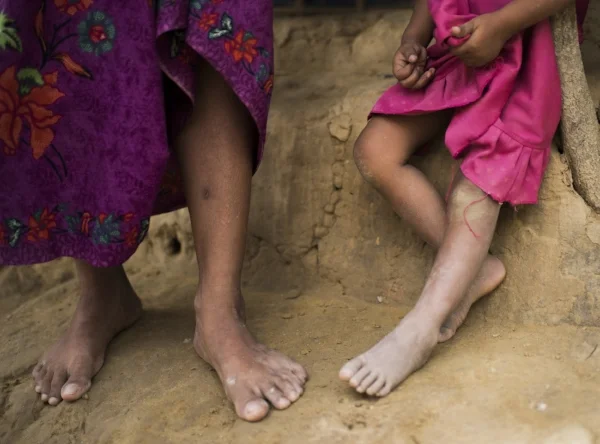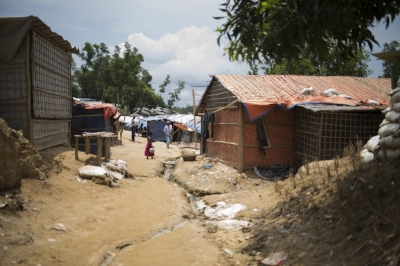To the Rohingya Woman Who Showed Me Her Bullet Wound

In August 2017, Myanmar’s military began a brutal crack down on the minority Muslim Rohingya community, reportedly in response to attacks on security outposts. The violence forced over 700,000 Rohingya to flee to neighboring Bangladesh, where they now live in overcrowded, under-resourced refugee camps. On October 24, 2018, the head of the U.N. Fact Finding Mission on Myanmar reported to the U.N. Security Council that the situation in Myanmar constitutes “an ongoing genocide that is taking place at the moment,” with up to 400,000 Rohingya who remain there facing severe repression. While officials from Myanmar and Bangladesh recently agreed to begin the repatriation process of refugees back to Myanmar as early as mid-November, there is no evidence that the Rohingya community’s rights and safety can be guaranteed.
I am sitting on the airplane when, for the first time, I cry. Planes are a good place to cry, alone in the sterile silence of strangers plugged into their screens.
It had been easier to be stoic during the days on the ground, drenched in my own sweat and surrounded by the smoke and the din that is Kutupalong — the largest and most densely packed refugee camp in the world, situated on the outskirts of Cox’s Bazar in Bangladesh. The work had been too urgent and the environment too brutal for unguarded emotion.
Photo courtesy of Hailey Sadler
But now in the darkness of the airplane, suspended somewhere between Dhaka and D.C., I find your face is all I can see.
I met you on my last morning in the camps as I was weaving through the maze of makeshift shelters, just one corner of this vast settlement. I had spent several days collecting images and stories about the humans caught up in this massive refugee crisis, but I wanted to squeeze in a few final hours of photographing before an afternoon flight out of Cox’s Bazar’s tiny airport. The timeline was a bit ambitious (or actually unwise, now in hindsight -- I would end up missing the flight and taking a three-hour, bone-rattling jeep ride, 20-minute boat ride, and last jaunt in a tuk-tuk just to get to Chittagong in time for the last flight to Dhaka.) But in those final few hours in the camps, I met you. Dildar. The young woman who showed me her scarred shin and whose face I can’t forget.
“She is precious,” I say. “Do you have any other children?” Normally, this would be an innocuous question. Here, in these close, human-crammed camps of families fleeing unspeakable horrors, it’s the kind of query that unlocks a story.”
Since August 2017, over 700,000 Rohingya fled here from their homes in Myanmar to escape a vicious escalation of violence by the military -- carrying with them horror stories of rape, torture, murder, and the razing of entire villages. While the history and political context around the atrocities against the minority Muslim Rohingya community in Myanmar are complex, the human suffering here is not: the brutal, slum-like conditions of the camp are impossible to ignore. Streets thick with mud. Toilets overflowing with sewage after a downpour. Fragile shelters stacked shoulder to shoulder.
But the suffering is not only the presence of these harsh realities, it is also the aching absences. Nearly every family is a checkerboard of missing members -- fathers whose locations are unknown, children who burned alive, babies who drowned. The camps are crowded with the pain of that missing.
Amid this, you stand out. I’m still not sure why. I had already told my friend, who was doubling as my translator, that we should leave now in order to make my flight.
But your eyes catch mine like a punch in the throat, and I cannot leave. From the doorway of a shelter built on an orange-brown dirt cliff, perhaps six feet above the pathway where I am walking, I see you. The darkness of the doorway behind you frames your face, as does the rose-colored scarf thrown over your head. You sit with your knees pulled up to your chest — how I like to sit, too. You’re wearing an expression I can’t pretend to read, except perhaps that it is the look of surviving: that mix of deep pain, drained of shock, with the remnants of a raw strength necessary to exist.
Photo courtesy of Hailey Sadler
Beside you, a small girl leans against the bamboo pole propping up the shelter. She is wearing a pink skirt pulled high up on her chest to serve as a dress. She wears a string of pearls around her neck.
I smile. You don’t smile back but lift a hand, motioning me to photograph the girl. I do. She is your daughter, I learn, as we haltingly make conversation through the translator. “Samira,” you say when I ask her name. She is three-years-old. Your name is Dildar, you tell me.
“She is precious,” I say. “Do you have any other children?” Normally, this would be an innocuous question. Here, in these close, human-crammed camps of families fleeing unspeakable horrors, it’s the kind of query that unlocks a story. A similar story each time, but with variations on the images, horrors, loves, and lives destroyed. The pain still feels new. Some stories are scabbed over; some bleed fresh.
You tell yours, without flinching.
Samira is one of your four children who are still alive. There were seven the night the military came raping, killing, and burning through your village. You and your family fled. Two of your sons and a daughter were hit by bullets as they ran. They were eighteen, twelve, and three years old. Did they die on the spot? I did not ask. You ran for your life and the lives of your other four children.
Telling me to move closer, you lift the hem of your dress, inch it up your shin, to show a purplish scar where a bullet found your leg that night. Samira watches me, you, then sits down in the dirt and sticks out one leg next to yours. Her hands twist the fabric of her skirt-turned-dress and she looks up at us without expression.
That night you fled was nine months ago. You were five months pregnant with the baby whose whimper I can hear through the doorway behind you. You walked nine days on your wounded leg, pregnant, toting your four other children to get to the shores of Bangladesh, to this -- refuge?
“Life in the camp is hard,” you say. “The house is no good. The rains are coming. And the heat…”
Photo courtesy of Hailey Sadler
Oh, the heat. Denuded by the mass deforestation that occurred when families stripped the forests of trees to build these shelters, there is virtually no escape from the oppressive heat. Umbrellas serve as flimsy defense. The shade inside the 8x8’ shelters is stifling. Walking around, it feels like the sun is trying to beat you into the orange dirt by the sheer weight of its rays. It’s brutal, yet the heat is only one of the compounding threats that have morphed into the rhythms of daily life here — violence, trafficking, limited resources and rations from the international community, the flooding and landslides of monsoon season from November to April, lacking medical supplies and the risk of infectious diseases like cholera, measles, and diphtheria.
“It’s hard here,” you say. Not a plea for pity, or sympathy. Just a fact. You drop your skirt and the scar disappears from view behind the red and blue flowers of the hem.
As you are speaking, some men spot my camera and notepad. With loud voices, they share stories of that night the military came. Maybe 15 minutes goes by. My translator signals that we really have to leave now, to catch my flight.
I look back. Samira is leaning against the bamboo pole again, her pink skirt and pearls looking fragile and out of place against the dirt and dust. I want to somehow finish your story with you, but there is no finish. Instead, I wave to both of you, putting my hand over my heart in a gesture of something —compassion, solidarity, respect? I’m not sure. It feels weak in the face of what you have shared with me. I am under no illusions that our interaction has left you with anything meaningful, except a listening ear and a quick smile when you saw Samira’s portrait on my camera screen. I won’t know until later how closely your story will cling to me.
For now, I tug my scarf a little closer around my neck and, hoisting my camera over my shoulder, turn to go.
I open my eyes. My forehead is pressed against the cool glass of the plane window. It's dark, except for the constellation of other passengers’ glowing T.V. screens. I can still hear your voice — matter-of-fact, monotone, relaying your story as with a verbal shrug. Every one of the hundreds of thousands of shelters in these overcrowded camps holds a similar one. Like yours, these stories have no periods at the end, only ellipses.
*
The future for Rohingya refugees remains unclear. If you would like to donate to ongoing relief efforts, Medical Teams International, Doctors Without Borders, NoName Charity, and UNICEF are just a few of the organizations on the ground continuing to provide aid.
ABOUT THE AUTHOR
Hailey Sadler is an independent photojournalist and documentary photographer based out of Washington, D.C. Formerly a Congressional Communications Director, she left Capitol Hill to embed with the U.S. Marines in Helmand, Afghanistan and has now traveled to over 30 countries documenting underreported narratives and the complex human stories behind the headlines. Sadler is a member of the U.S. Press Association. You can find her on Instagram at @haileycsadler.
Header image by Hailey Sadler.














